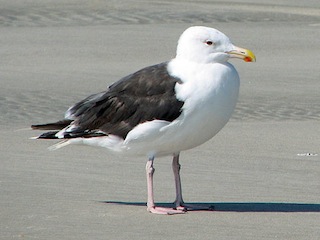 In winter, Great Black-backed Gulls will often venture inland to hunt for food: look out for them near inland pools or scavenging at disposal sites.
In winter, Great Black-backed Gulls will often venture inland to hunt for food: look out for them near inland pools or scavenging at disposal sites.
Photo: Amanda Scott
Scientific name: Larus marinus
Other common names: Black-back, Baagie (or Baigie) in Shetland, Greater Black-backed Gull
Cornish name: Goolan geyn du meur
Conservation status: UK Birds of Conservation Concern, Amber; IUCN Red List, Least Concern
What to look for:
- Colouring and appearanc : Large gull with black/dark-grey back and wings, white head and underparts, dull pink legs, webbed feet and robust yellow curved bill. Juveniles are pale brown streaked with white, developing a more distinctive white head and breast as they mature to adulthood at four to five years.
- Size: Length 68 to 79 cm, wingspan 150 to 170 cm.
- Where: Globally breeds on coasts of Europe and North America. In the UK can be found round the coast in breeding season, and may be seen further inland in winter.
- Call: Cackling call
- Similar species: Lesser Black-backed Gull, which is smaller and has yellow legs.
 The Great Black-backed Gull is hard to mistake, with its bulky build and that black back and wings contrasting with its bright white head and chest. This powerful bruiser of a bird is in fact larger than any other gull in the world.
The Great Black-backed Gull is hard to mistake, with its bulky build and that black back and wings contrasting with its bright white head and chest. This powerful bruiser of a bird is in fact larger than any other gull in the world.
It is resident round the coast of Britain, sometimes travelling inland or far out to sea in the winter to exploit food resources. An opportunistic and aggressive feeder, it has a wide and omnivorous diet. It can be found scavenging at rubbish dumps as well as nosing about among seaweed on the shore or seizing fish out at sea. Not restricting itself to scavenging, the Great Black-backed Gull will also aggressively predate smaller organisms, including smaller or injured birds, using its curved bill to attack them viciously. It will even pirate away food from other gulls. It swallows smaller prey whole, and breaks up larger items by shaking them. Molluscs or eggs are smashed on the ground to get at the goodies inside them.
Great Black-backed Gulls often nest in mixed colonies with Herring Gulls or Lesser Black-backed Gulls. Pairs are formed in the early spring. Both birds in the pair make a few nests – scrapes in the ground – and then choose the one that provides most shelter before lining it with seaweed, grasses and mosses. The clutch size is one to three eggs, and both parents share incubating and then feeding duties. The adults continue to care for the young for up to six months. The youngsters reach full sexual maturity after four to five years and can expect a reasonably long life: the oldest recorded was just under 25 years old.
Its Amber status in the UK is because of a recent decline in the non-breeding population.
Did you know…?
…In demand: Great Black-backed Gulls were once hunted for their feathers, which were used to adorn hats.
…Plain and simple: the scientific name Larus marinus means ‘gull of the sea’ – or, simply, seagull.
More information and references:
Svensson, L., Mullarney, K., Zetterstrom, D.,1986. Collins Bird Guide, second edition (translated by Christie, D., Svensson, L.). HarperCollins, London.
Published: November 2014
Author: Amanda Scott
Photos: Below: Amanda Scott; above: Dick Daniels [CC-BY-SA-3.0], via Wikimedia Commons
